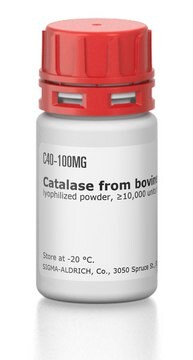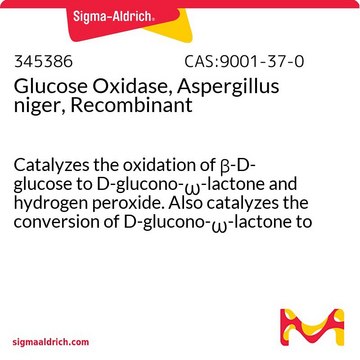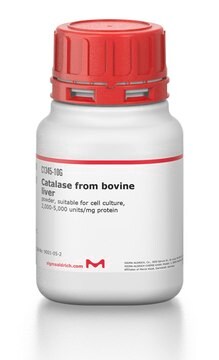Kluczowe dokumenty
G2133
Glucose Oxidase from Aspergillus niger
Type VII, lyophilized powder, ≥100,000 units/g solid (without added oxygen)
Synonim(y):
β-D-Glucose:oxygen 1-oxidoreductase, G.Od., GOx
About This Item
Polecane produkty
typ
Type VII
Poziom jakości
Postać
lyophilized powder
aktywność właściwa
≥100,000 units/g solid (without added oxygen)
masa cząsteczkowa
160 kDa
nie zawiera
extender
skład
Protein, ≥60%
Zastosowanie
diagnostic assay manufacturing
obecność zanieczyszczeń
Catalase ≤10 Sigma units/mg protein
Warunki transportu
wet ice
temp. przechowywania
−20°C
InChI
1S/C6H12O6/c7-1-2-3(8)4(9)5(10)6(11)12-2/h2-11H,1H2/t2-,3-,4+,5-,6-/m1/s1
Klucz InChI
WQZGKKKJIJFFOK-VFUOTHLCSA-N
Szukasz podobnych produktów? Odwiedź Przewodnik dotyczący porównywania produktów
Opis ogólny
pI: 4.2
Extinction coefficient: E1% = 16.7 (280 nm)
Glucose oxidase from Aspergillus niger is a dimer consisting of 2 equal subunits with a molecular mass of 80 kDa each. Each subunit contains one flavin adenine dinulceotide moiety and one iron. The enzyme is a glycoprotein containing ~16% neutral sugar and 2% amino sugars. The enzyme also contains 3 cysteine residues and 8 potential sites for N-linked glycosylation.
Glucose oxidase is capable of oxidizing D-aldohexoses, monodeoxy-D-glucoses, and methyl-D-glucoses at varying rates.
The pH optimum for glucose oxidase is 5.5, while it has a broad activity range of pH 4-7. Glucose oxidase is specific for β-D-glucose with a KM of 33-110 mM.
Glucose oxidase does not require any activators, but it is inhibited by Ag+, Hg2+, Cu2+, phenylmercuric acetate, and p-chloromercuribenzoate. It is not inhibited by the nonmetallic SH reagents: N-ethylmaleimide, iodoacetate, and iodoacetamide.
Glucose oxidase can be utilized in the enzymatic determination of D-glucose in solution. As glucose oxidase oxidizes β-D-glucose to D-gluconolactate and hydrogen peroxide, horseradish peroxidase is often used as the coupling enzyme for glucose determination. Although glucose oxidase is specific for β-D-glucose, solutions of D-glucose can be quantified as α-D-glucose will mutorotate to β-D-glucose as the β-D-glucose is consumed by the enzymatic reaction.
Zastosowanie
a) Biosensor development:
- Diazoresin nanofilm coatings on alginate microspheres: Srivastava, R. et al., Biotechnol. Bioeng., 91(1), 124-131 (2005).
- Paper-based glucose biosensor: Lankelma, J. et al., Anal. Chem., 84(9), 417-4152 (2012)
- Microfluidic device with glucose oxidase immobilized on hydrogel for glucose analysis of blood: He, R.-Y. et al., RSC Adv., 9, 32367-32374 (2019).
c) Enzymatic fuel-cells with chitosan-based membranes: Bahar, T., and Yazici, M.S., Electroanalysis, 32(6), 1304-1314 (2020).
Działania biochem./fizjol.
Jakość
Definicja jednostki
Postać fizyczna
Komentarz do analizy
Hasło ostrzegawcze
Danger
Zwroty wskazujące rodzaj zagrożenia
Zwroty wskazujące środki ostrożności
Klasyfikacja zagrożeń
Resp. Sens. 1
Kod klasy składowania
11 - Combustible Solids
Klasa zagrożenia wodnego (WGK)
WGK 1
Środki ochrony indywidualnej
dust mask type N95 (US), Eyeshields, Faceshields, Gloves
Certyfikaty analizy (CoA)
Poszukaj Certyfikaty analizy (CoA), wpisując numer partii/serii produktów. Numery serii i partii można znaleźć na etykiecie produktu po słowach „seria” lub „partia”.
Masz już ten produkt?
Dokumenty związane z niedawno zakupionymi produktami zostały zamieszczone w Bibliotece dokumentów.
Protokoły
Enzymatic Assay of Glucose Oxidase
Aktywność oksydazy glukozy mierzona za pomocą ciągłego testu spektrofotometrycznego przy 500 nm, wskazującego szybkość utleniania glukozy.
Nasz zespół naukowców ma doświadczenie we wszystkich obszarach badań, w tym w naukach przyrodniczych, materiałoznawstwie, syntezie chemicznej, chromatografii, analityce i wielu innych dziedzinach.
Skontaktuj się z zespołem ds. pomocy technicznej









